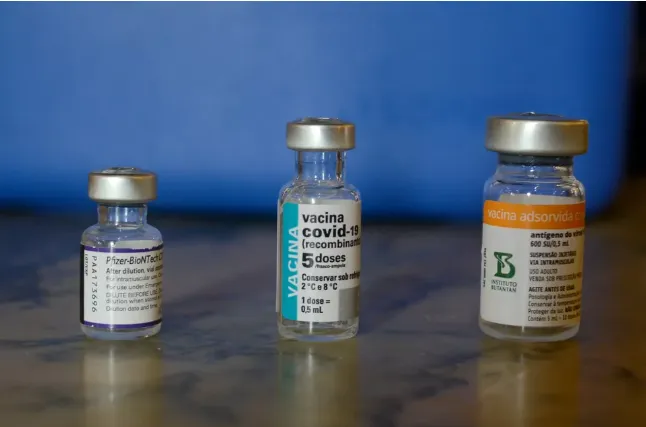Portuguese and English
more studies on the combination is AstraZeneca, which uses "viral vector" technology, that is, it is based on a modified virus to introduce part of the genetic material of the coronavirus into the body and induce protection;
Oxford University researchers have been investigating combinations since February 2020;
First survey, dubbed "Com-COV1", the combination of AstraZeneca and Pfizer in 850 volunteers over 50 years of age;
Combination of the 1st dose of AstraZeneca with the 2nd from Pfizer generated more antibodies and T cells than the complete regimen with AstraZeneca;
In Spain, the CombiVacs study, by the Carlos III Health Institute, gathered 676 people between 18 and 59 years old. The results released in May show that the AstraZeneca and PFizer blend resulted in more than double the antibodies generated by two doses of AstraZeneca;
In South Korea, a study of 499 healthcare professionals concluded in late July that the combination of AstraZeneca with Pfizer generated six times higher levels of neutralizing antibodies;
In Germany, Chancellor Angela Merkel, 66, received the 1st dose of AstraZeneca and then was vaccinated with Moderna in the second dose: the aim was to encourage a new vaccination strategy after the country recommended AstraZeneca only for people over 60 years old. Moderna also uses messenger RNA (mRNA) technology, capable of encoding the virus's crown protein S, and introduces it into the body with the help of a fat nanoparticle to induce the body's natural protection.
Research in Denmark found that the AstraZeneca/PFizer regimen reduced the risk of infection by 88%, comparable to 90% for the PFizer-only regimen.
In Brazil, since the end of June, pregnant women who took AstraZeneca were authorized to receive Pfizer in the second dose.
In July, the Ministry of Health announced a study to assess the need for a third dose for those vaccinated with CoronaVac: the objective is to evaluate the effectiveness of the booster dose with a different immunizing agent. Results have not yet been released.
Mixing with Sputnik V
Due to problems in the supply of Sputnik V, countries in Latin America had to adopt a similar tactic. The Russian immunizer also uses the viral vector.
In Argentina, Health Minister Carla Vizzotti announced in early August that preliminary results indicated "satisfactory" and "encouraging" results in the combination of Sputnik V and AstraZeneca. There were also tests with Sinopharm's immunizer, but so far the results have not been "conclusive".
source:https://g1.globo.com/bemestar/coronavirus/noticia/2021/09/14/combinacao-de-tipos-diferentes-de-vacinas-contra-a-covid-pode-ser-vantajoso-e- generate-plus-answer.ghtml
mais estudos sobre a combinação é a AstraZeneca, que usa a tecnologia de "vetor viral", ou seja, é baseada em um vírus modificado para introduzir parte do material genético do coronavírus no organismo e induzir a proteção;
Pesquisadores da Universidade de Oxford investigam desde fevereiro de 2020 as combinações;
Primeira pesquisa, batizada de "Com-COV1", a combinação AstraZeneca e Pfizer em 850 voluntários com mais de 50 anos;
Combinação da 1ª dose de AstraZeneca com a 2ª da Pfizer gerou mais anticorpos e células T do que o regime completo com AstraZeneca;
Na Espanha, estudo CombiVacs, do Instituto de Saúde Carlos III, reuniu 676 pessoas entre 18 e 59 anos. Os resultados divulgados em maio apontam que a mistura AstraZeneca e PFizer resultou em mais que o dobro dos anticorpos gerados por duas doses de AstraZeneca;
Na Coreia do Sul, estudo com 499 profissionais de saúde, concluiu no final de julho que a combinação de AstraZeneca com Pfizer gerou níveis seis vezes maiores de anticorpos neutralizantes;
Na Alemanha, a chanceler Angela Merkel, de 66 anos, recebeu a 1ª dose de AstraZeneca e depois foi vacinada com a Moderna na segunda dose: objetivo era incentivar nova estratégia de vacinação após o país recomendar a AstraZeneca apenas para maiores de 60 anos. A Moderna também usa a tecnologia do RNA mensageiro (mRNA), capaz de codificar a proteína S da coroa do vírus, e o introduz no corpo com a ajuda de uma nanopartícula de gordura para induzir a proteção natural do corpo.
Pesquisa na Dinamarca apontou que o regime AstraZeneca/PFizer reduziu em 88% o risco de infecção, número comparável aos 90% para o regime exclusivo da PFizer.
No Brasil, desde o fim de junho as grávidas que tomaram AstraZeneca foram autorizadas a receber a Pfizer na segunda dose.
Ministério da Saúde anunciou, em julho, um estudo para avaliar a necessidade de uma terceira dose para os vacinados com CoronaVac: o objetivo é avaliar eficácia da dose de reforço com um imunizante diferente. Resultados ainda não foram divulgados.
Mistura com a Sputnik V
Por causa de problemas no fornecimento da Sputnik V, países da América Latina precisaram adotar tática semelhante. O imunizante russo também utiliza o vetor viral.
Na Argentina, a ministra da Saúde, Carla Vizzotti, anunciou no começo de agosto que os resultados preliminares indicavam resultados "satisfatórios" e "encorajadores" na combinação da Sputnik V com a AstraZeneca. Também houve testes com o imunizante da Sinopharm, mas até então os resultados não foram "conclusivos".
fonte:https://g1.globo.com/bemestar/coronavirus/noticia/2021/09/14/combinacao-de-tipos-diferentes-de-vacinas-contra-a-covid-pode-ser-vantajoso-e-gerar-mais-resposta.ghtml

